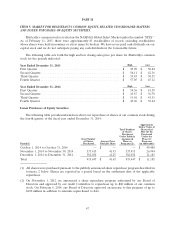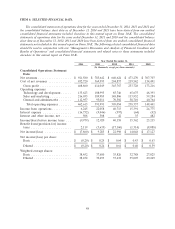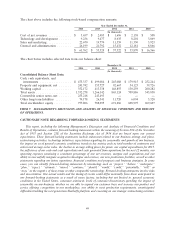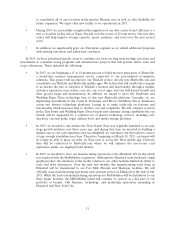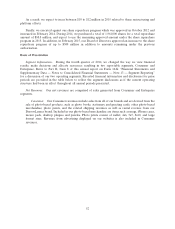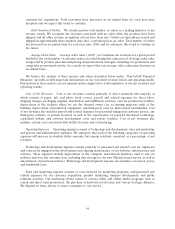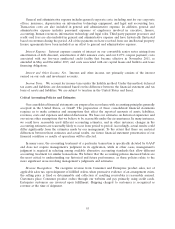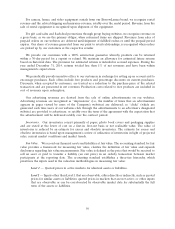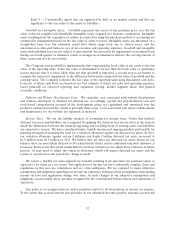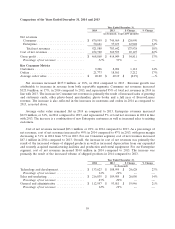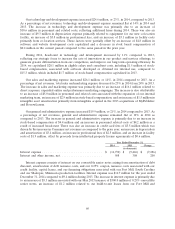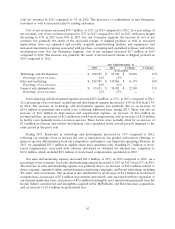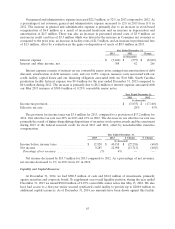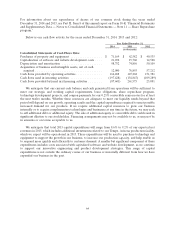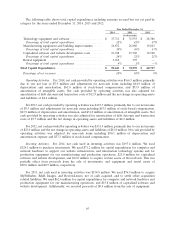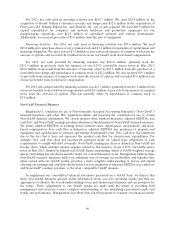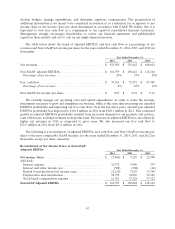Shutterfly 2014 Annual Report Download - page 58
Download and view the complete annual report
Please find page 58 of the 2014 Shutterfly annual report below. You can navigate through the pages in the report by either clicking on the pages listed below, or by using the keyword search tool below to find specific information within the annual report.Level 3 — Unobservable inputs that are supported by little or no market activity and that are
significant to the fair value of the assets or liabilities.
Goodwill and Intangible Assets. Goodwill represents the excess of the purchase price over the fair
value of the net tangible and identifiable intangible assets acquired in a business combination. Intangible
assets resulting from the acquisition of entities accounted for using the purchase method of accounting are
estimated by management based on the fair value of assets received. Intangible assets are amortized on a
straight-line basis over the estimated useful lives which range from one to sixteen years, and the
amortization is allocated between cost of net revenues and operating expenses. Goodwill and intangible
assets with indefinite lives are not subject to amortization, but are tested for impairment on an annual basis
during our fourth quarter or whenever events or changes in circumstances indicate the carrying amount of
these assets may not be recoverable.
The Company tests goodwill for impairment by first comparing the book value of net assets to the fair
value of the reporting units. If the fair value is determined to be less than the book value or qualitative
factors indicate that it is more likely than not that goodwill is impaired, a second step is performed to
compute the amount of impairment as the difference between the estimated fair value of goodwill and the
carrying value. The Company estimates the fair value of the reporting units using discounted cash flows.
Forecasts of future cash flows are based on our best estimate of future net sales and operating expenses,
based primarily on expected reporting unit expansion, pricing, market segment share, and general
economic conditions.
Software and Website Development Costs. We capitalize costs associated with website development
and software developed or obtained for internal use. Accordingly, payroll and payroll-related costs and
stock-based compensation incurred in the development phase are capitalized and amortized over the
product’s estimated useful life, which is generally three years. Costs associated with minor enhancements
and maintenance for our website are expensed as incurred.
Income Taxes. We use the liability method of accounting for income taxes. Under this method,
deferred tax assets and liabilities are recognized by applying the statutory tax rates in effect in the years in
which the differences between the financial reporting and tax filing bases of existing assets and liabilities
are expected to reverse. We have considered future taxable income and ongoing prudent and feasible tax
planning strategies in assessing the need for a valuation allowance against our deferred tax assets. In 2014,
our valuation allowance against certain California and South Carolina deferred tax assets increased to
$4.9 million from $2.9 million in 2013. We believe that all other net deferred tax assets shown on our
balance sheet are more likely than not to be realized in the future and no additional valuation allowance is
necessary. In the event that actual results differ from those estimates or we adjust those estimates in future
periods, we may need to adjust the valuation allowance, which will impact deferred tax assets and the
results of operations in the period the change is made.
We report a liability for unrecognized tax benefits resulting from uncertain tax positions taken or
expected to be taken in a tax return. The application of income tax law is inherently complex. Laws and
regulations in this area are voluminous and are often ambiguous. We are required to make subjective
assumptions and judgments regarding our income tax exposures. Interpretations and guidance surrounding
income tax laws and regulations change over time. As such, changes in our subjective assumptions and
judgments can materially affect amounts recognized in the consolidated balance sheets and statements of
operations.
Our policy is to recognize interest and/or penalties related to all tax positions in income tax expense.
To the extent that accrued interest and penalties do not ultimately become payable, amounts accrued will
57


